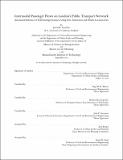| dc.contributor.advisor | Nigel H.M. Wilson, Harilaos Koutsopoulos and John P. Attanucci. | en_US |
| dc.contributor.author | Gordon, Jason B. (Jason Benjamin) | en_US |
| dc.contributor.other | Massachusetts Institute of Technology. Dept. of Civil and Environmental Engineering. | en_US |
| dc.coverage.spatial | e-uk-en | en_US |
| dc.date.accessioned | 2013-03-28T18:25:35Z | |
| dc.date.available | 2013-03-28T18:25:35Z | |
| dc.date.copyright | 2012 | en_US |
| dc.date.issued | 2012 | en_US |
| dc.identifier.uri | http://hdl.handle.net/1721.1/78242 | |
| dc.description | Thesis (M.C.P.)--Massachusetts Institute of Technology, Dept. of Urban Studies and Planning; and, (S.M. in Transportation)--Massachusetts Institute of Technology, Dept. of Civil and Environmental Engineering, 2012. | en_US |
| dc.description | This electronic version was submitted by the student author. The certified thesis is available in the Institute Archives and Special Collections. | en_US |
| dc.description | Cataloged from student-submitted PDF version of thesis. | en_US |
| dc.description | Includes bibliographical references (p. 147-155). | en_US |
| dc.description.abstract | Urban public transport providers have historically planned and managed their networks and services with limited knowledge of their customers' travel patterns. While ticket gates and bus fareboxes yield counts of passenger activity in specific stations and vehicles, the relationships between these transactions-the origins, interchanges, and destinations of individual passengers-have typically been acquired only through costly and therefore small and infrequent rider surveys. Building upon recent work on the utilization of automated fare-collection and vehicle-location systems for passenger-behavior analysis, this thesis presents methods for inferring the full journeys of all riders on a large public transport network. Using complete daily sets of data from London's Oyster farecard and iBus vehicle-location system, boarding and alighting times and locations are inferred for individual bus passengers, interchanges are inferred between passenger trips of various public modes, and full-journey origin-interchange-destination matrices are constructed, which include the estimated flows of non-farecard passengers. The outputs are validated against surveys and traditional origin-destination matrices, and the software implementation demonstrates that the procedure is efficient enough to be performed daily, enabling transport providers to observe travel behavior on all services at all times. | en_US |
| dc.description.statementofresponsibility | by Jason B. Gordon. | en_US |
| dc.format.extent | 155 p. | en_US |
| dc.language.iso | eng | en_US |
| dc.publisher | Massachusetts Institute of Technology | en_US |
| dc.rights | M.I.T. theses are protected by
copyright. They may be viewed from this source for any purpose, but
reproduction or distribution in any format is prohibited without written
permission. See provided URL for inquiries about permission. | en_US |
| dc.rights.uri | http://dspace.mit.edu/handle/1721.1/7582 | en_US |
| dc.subject | Urban Studies and Planning. | en_US |
| dc.subject | Civil and Environmental Engineering. | en_US |
| dc.title | Intermodal passenger flows on London's public transport network : automated inference of full passenger journeys using fare-transaction and vehicle-location data | en_US |
| dc.title.alternative | Automated inference of full passenger journeys using fare-transaction and vehicle-location data | en_US |
| dc.type | Thesis | en_US |
| dc.description.degree | S.M.in Transportation | en_US |
| dc.description.degree | M.C.P. | en_US |
| dc.contributor.department | Massachusetts Institute of Technology. Department of Civil and Environmental Engineering | |
| dc.contributor.department | Massachusetts Institute of Technology. Department of Urban Studies and Planning | |
| dc.identifier.oclc | 830539087 | en_US |
